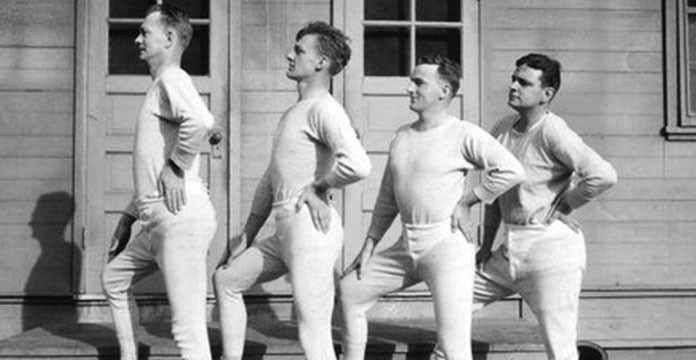Picking its name from its “T” shape, the t-shirt is a distant cousin of the union suit. Worn as intimate apparel with long sleeves and legs, the union suit, during the late 19th century, was a sort of one-piece undergarment, initially made for women. With time, this red flannel garment gained popularity and was finally adopted by men. Featuring a buttoned upfront and the essential comfort it offered, the union suit, had subsequently seized the reputation of being hailed as the “working men’s wear” and thus considered “rural” or “unsophisticated”.
During or soon after the Spanish-American war of 1898, the union suit, amassed popularity when the U.S Navy used it as a slip-on undergarment, underwent a capricious makeover. Losing its buttons, red being replaced by white and with its top cut off and used as a separate piece of undergarment, the t-shirt that was thus born, bore hallmark crew neck and short sleeves. Soon this slip-on undergarment was adopted by marines, sailors, miners, stevedores and workers from across all other fields of occupation. Light, washable, providing a comfortable fit, and most importantly keenly priced, the t-shirt became the staple piece of intimate, for tropical climates. A hit among young men, the t-shirt started being manufactured in different colours and varied patterns.
The word “T-shirt” became a part of American English by the 1920s when it appeared in the Merriam-Webster Dictionary and by the Great Depression of 1929, the t-shirt which had made its place in the mainstream was the most favoured bottom garment to be sported while running chores.
It was only after the 1940’s that is after World War II, that veterans started donning the t-shirt as a casual garment often teamed with their trousers. In 1948, this coveted garment was used as a canvas to feature Governor Thomas E. Dewey’s slogan, “Dew-IT with Dewey,” for the duration of the presidential campaign. In 1950’s after Marlon Brando Jr in his role as Stanley Kowalski in the movie A Streetcar Named Desire sported a figure-hugging t-shirt, the garment finally graduated as in vogue, often hailed as a “sexy, stand-alone, outer-wear garment”
In the 1960’s with the innovation of the durable plastisol, the use of the t-shirt was extended. The “sexy” clothing was seen as a platform to showcase opinions and slogans of various movements. These first graphic t-shirts carried anti-war slogans opposing the Vietnam War and various company logos. Following this trend, music luminaries like Janis Joplin and Jimi Hendrix, started wearing shirts inked with slogans and tie-dyed patterns.
Used as promotional merchandise ever since, bearing company logos, brand names, movement slogans, quotes, graphics of favourite cartoon or television series character, the t-shirt has stood the test of time, rendering itself to fashion experiments since its early stages. The modern-day t-shirt is viewed not only as a channel for self-expression but also as the most favoured go-to style statement to resort to.


